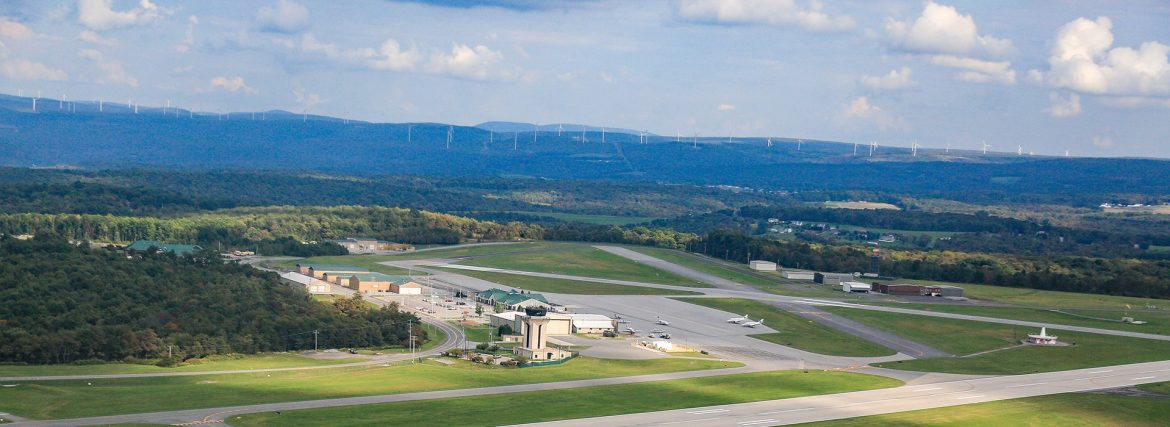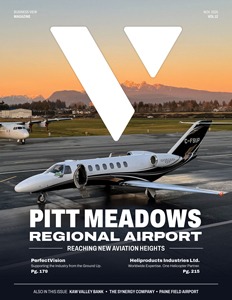Advanced Air Mobility Meets Workforce Innovation
A Dynamic Airport Positioning Itself as an Innovation Hub in an Industry Facing Critical Workforce Shortages.
When John Murtha Johnstown-Cambria County Airport opened in 1948, TWA DC-3s carried the first passengers from this Pennsylvania community 57 miles east of Pittsburgh. Nearly eight decades later, the airport has evolved far beyond its modest beginnings, now serving as a crucial link between the region’s 133,000 residents and major urban hubs while playing an increasingly strategic role in aviation innovation.
The airport operates daily United Express service to Washington Dulles and Chicago O’Hare using 50-seat jets operated by SkyWest Airlines. “Our passenger volume has been going well since SkyWest became our air carrier back in 2020,” says Cory Cree, the airport manager. “Our enplanements have increased every year in 2022, 2023, 2024, and 2025.”
This consistent growth proved significant enough that in 2024, the Federal Aviation Administration reclassified the airport from a non-primary non-hub to a primary non-hub. The designation brings additional federal funding, a crucial resource for an airport managing both commercial service and an extensive military presence that includes Pennsylvania Army National Guard aviation units and the 258th Combat Airfield Operations Squadron.
Building a Full-Service Experience
The airport’s strategy creates a destination that serves travelers and the broader community. In January 2025, Balance restaurant opened its doors in the terminal, operating seven days a week. The establishment, which also runs a location in downtown Johnstown, attracts passengers and local residents who visit specifically to dine. “We have people coming to the restaurant just to eat rather than just passengers flying out,” Cree explains.
“We’re hitting it from both directions, giving our passengers a food option as well as getting the general public here to the restaurant and letting them then find out about our services.”
Hertz relocated its headquarters from downtown Johnstown to the airport in January 2022, creating another dual-purpose amenity. The rental car company supports airline passengers while also serving area residents who need vehicles. Nulton Aviation, the airport’s full-service FBO, rounds out the facility’s offerings with fuel services, flight support, flight training, aircraft storage, and maintenance capabilities.
Cultivating Tomorrow’s Workforce
The aviation industry faces a looming crisis that threatens to ground aircraft and delay maintenance schedules nationwide. Boeing projects the need for 610,000 new civil maintenance technicians over the next 20 years, while a 2024 Pipeline Report forecasts a 20 percent shortfall by 2028 as baby boomers retire and younger workers remain largely unaware of career opportunities in aviation maintenance. Johnstown is responding with programs designed to feed this pipeline.

In August 2024, St. Francis University (SFU) opened an aviation maintenance technician school (AMTS) at the airport. “That is a program where students can come out in 21 months with a certificate to be an aircraft mechanic, which is a great thing because we see projections that in the 2030s, the industry will be needing more than 25,000 mechanics,” Cree notes. The timing proves critical as current estimates show commercial aviation alone will be 31,000 mechanics short of its needs by 2031.
The airport also has a growing flight training program in the Nulton Aviation Flight Academy, which is in the same hangar complex as SFU’s AMTS, creating a campus atmosphere for learning. “The Flight Academy has approximately 85 students that can earn their private pilot license and can continue to earn their instrument pilot, commercial pilot, and a multi engine rating. ” Cree says..
The strategy recognizes a fundamental challenge facing the industry. Many high school graduates remain unaware of aviation maintenance careers, often choosing more widely advertised paths in other sectors. By establishing visible training programs at the airport and creating clear pathways from education to employment, Johnstown aims to attract young talent to an industry desperate for skilled hands.
Infrastructure and Innovation
The year 2026 will test the airport’s capacity to manage multiple construction projects simultaneously while maintaining operations. Cree describes an ambitious schedule that includes crack sealing and seal coating the terminal apron, strengthening concrete stands to accommodate larger aircraft, and resealing runway 5-23 with new pavement markings. The airport will also install LED lights and signs on taxiways Alpha, Alpha 1, Bravo, and Bravo 1, modernizing the facility’s ground navigation infrastructure.
Passenger growth drives additional expansion. “As our passengers go up, our parking lot gets filled up,” Cree explains. “We’re planning to expand are parking lot and are also looking to expand our TSA screening and passenger hold area so that we can accommodate larger aircraft, larger flights, more flights.”
Behind these immediate improvements lies a more ambitious project that positions the airport as a research and development hub. The facility is pursuing construction of a regional jet hangar combined with an innovation center, a 63,000-square-foot facility designed to attract aviation companies seeking space for testing and collaboration.
The innovation center concept is a strategic shift in how regional airports compete for economic development. Rather than simply providing space for aircraft operations, the facility aims to become a destination for companies developing new aviation technologies. Funding for infrastructure development comes from multiple sources, including a $4 million congressional directed spending allocation from Congressman GT Thompson and a $1.5 million state multimodal grant. These funds supported construction of a 162-space parking lot behind the St. Francis school and flight training facilities, as well as expansion of the access road to accommodate two-lane traffic and tractor-trailer deliveries.
“The airport also completed security improvements to fencing and gating systems while reconstructing a large aircraft hangar apron,” Cree says. “Site preparation for general aviation T-hangars will begin in 2026, with the first phase of the RJ hangar and innovation center going out for bids during the same period,” he adds. Congressman Dr. John Joyce’s help for funding the RJ Hangar/Innovation has been critical with a $4 million congressional directed spending allocation.
The expanded access road will eventually connect to the innovation center, creating a development corridor with 130 acres designated as both a Keystone Opportunity Expansion Zone and an Airport Land Development Zone, offering tax credits and $2,100 in tax relief per full-time employee to companies that relocate to the site.
Embracing Advanced Air Mobility
While many regional airports view drones and autonomous aircraft as threats to traditional aviation, Johnstown has adopted a different approach. The facility actively pursues integration of advanced air mobility technologies, positioning itself at the forefront of an industry projected to grow from $1.47 billion in 2024 to $4.68 billion by 2032.
“A lot of people think advanced air mobility, they don’t want to have anything to do with it regarding traditional aviation, but we don’t want to put our head in the sand and say advanced air mobility isn’t coming here,” Cree states.
“We want to embrace it and make sure that the skies are safe for everyone, for both the conventional aircraft and advanced air mobility, the drones, the unmanned, the autonomous aircraft, and the electric aircraft.”
The airport’s most visible advanced air mobility initiative involves the Drone 814 program, which delivers life-saving medical supplies like AEDs, EPIPENS, and Marcan to emergencies. “The project received a $1.9 million US Department of Transportation Smart Grant for phase one, demonstrating the viability of drone-based medical logistics in a region where ground transportation can be time-consuming and challenging,” Cree says.

Major healthcare systems nationwide have begun adopting similar technologies, with Mayo Clinic, Cleveland Clinic, and Intermountain Health partnering with drone delivery companies to achieve delivery times as short as 10 minutes.
Phase two of Drone 814 project will expand operations across Pennsylvania to multiple locations, moving beyond Cambria County’s initial service area. The program also pursues a crucial financial sustainability component by working with government agencies and Medicare on insurance coverage for drone deliveries.
“Right now, if you have an emergency and you need to get an ambulance to take you to the hospital, you can get some of that cost paid through insurances,” Cree notes. “We want to get similar insurance coverage of medical delivery with drones.”
Recently, the airport hosted high-level Pennsylvania transportation officials alongside representatives from the University of Pittsburgh, St. Francis University, St. Vincent, and Mount Aloysius, along with multiple industry leaders. The collaboration seeks to establish advanced air mobility infrastructure and protocols that ensure safe integration with conventional aircraft operations. “We’re working with other entities and collaborating,” says Cree. “We brought together a lot of the people that we’re working with, coordinating with universities, working with multiple industry leaders within the space, and we’re doing so to grow advanced air mobility and to establish it here at Johnstown.”
The airport envisions itself as a potential training and certification hub for the emerging drone industry. Companies could send employees to Johnstown for credentialing, then deploy them with drones back at their home operations. This model recognizes two distinct use cases for drone technology: commercial pilots who fly drones as their primary career, and professionals in construction, HVAC, or bridge inspection who use drones as tools alongside their primary expertise.

Cory Cree, Airport Manager.
“If you are a construction company, you could use the drone to inspect the bridge that you’re constructing rather than sending employees into a dangerous area,” Cree explains. “You could use drones in the HVAC industry where your HVAC technician also is a drone pilot. He’s not a drone pilot by career, but he has the drone pilot certification to be a tool in his tool belt.”
A Collaborative Vision for Growth
The airport’s transformation relies on support from multiple levels of government and strong partnerships with private sector entities. “Federal, state, and local political leaders have consistently backed the facility’s expansion plans,” Cree says, “recognizing its role in regional economic development. Beyond Congressman Thompson’s $4 million allocation, the airport benefits from tax incentive programs designed to attract businesses to its 130-acre development zone.”
The Keystone Opportunity Expansion Zone and Airport Land Development Zone offer companies significant financial advantages, including tax credits and $2,100 in tax relief for every full-time employee hired at the airport. These incentives target defense contractors already present in the Johnstown area, including Lockheed Martin, Martin Baker, Kongsberg, and DRS. The region’s defense industry generates over $100 million annually in federal contracts, establishing Johnstown as a significant player in high-tech military applications.
“It’s definitely not just me. It’s a great team,” Cree emphasizes. “We have a great airport authority board, a nine-member board of very supportive businesspeople in the community that support the airport. We have a great FBO that we’re working with in Nulton Aviation Services. And the federal, the state, and the local political leaders are all very supportive and help us seek and obtain grant funds.”
The airport’s staff maintains 24-hour, year-round operations while pursuing these ambitious development goals. Cree articulates a three-part vision for the facility’s future: continuing expanding airline service for business and leisure travelers, growing hangar capacity and infrastructure to support the aviation community across general aviation and corporate sectors, and leading in advanced air mobility innovation to enable safe integration of unmanned aircraft systems into the national airspace. For a regional airport in a Rust Belt community once defined by industrial decline, Johnstown is writing a distinctly forward-looking chapter in Pennsylvania aviation.
AT A GLANCE
Who: John Murtha Johnstown-Cambria County Airport
What: A regional civil-military airport serving commercial passengers via United Express, housing Pennsylvania National Guard units, and developing as an advanced air mobility and aviation workforce training hub
Where: Richland Township, Cambria County, Pennsylvania
Website: www.flyjst.com
PREFERRED VENDORS/PARTNERS
Concurrent Technologies Corporation: www.ctc.com
Concurrent Technologies Corporation (CTC) is an independent, nonprofit, applied scientific research and development professional services organization. CTC collaborates with its technology transition affiliate, Enterprise Ventures Corporation, to provide full lifecycle solutions through research, development, test, and evaluation work. We deliver innovative solutions that safeguard national security, retain U.S. technological advantage, and ensure the primacy of American manufacturing.
University of Pittsburgh at Johnstown: www.johnstown.pitt.edu
The University of Pittsburgh at Johnstown was founded in 1927 and is the first and largest regional campus of the University of Pittsburgh. Offering over 50 undergraduate degrees and certificates, Pitt-Johnstown is a vital knowledge center and the foremost contributor to the region’s educational, social, cultural, and economic development.



